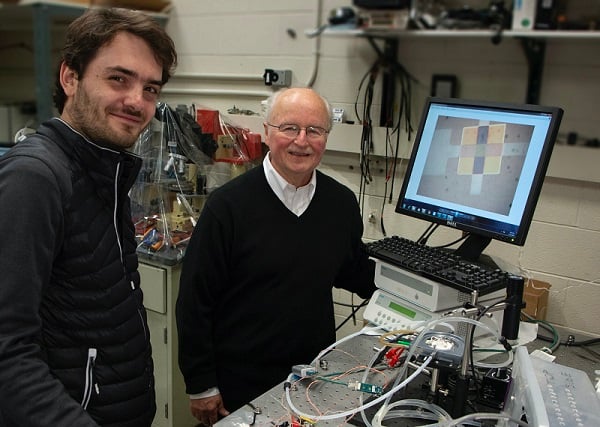CAMBRIDGE, Mass., Jan. 18, 2022 — Research from MIT and Kyushu University suggests that light could provide significantly improved performance to fuel cells, lithium batteries, and other devices that rely on the movement of charged atoms. The work introduces and demonstrates a way to use light to lower the barrier encountered by ions at grain boundaries.
The method increases the flow of ions by a factor of three.
“We expect that we should be able to increase that to orders of magnitude by optimizing the system,” said Harry Tuller, the R.P. Simmons Professor of Ceramics and Electronic Materials in MIT’s Department of Materials Science and Engineering.
The researchers demonstrated the effect of light on the movement of oxygen ions through a popular solid electrolyte composed of ceria and gadolinium.

MIT professor Harry L. Tuller (right), graduate student Thomas Defferriere (left), and colleagues have shown how light can boost the performance of lithium batteries, fuel cells, and other devices based on the movement of charged atoms, or ions. Courtesy of Denis Paiste, MIT Materials Research Laboratory.
“Our findings are also expected to apply to other ceramics systems that conduct different elements,” said Thomas Defferriere, a graduate student at MIT.
To explain the concept of the work, Defferriere introduced the idea of a barrier represented by a gorge between two mountains.
“A person trying to get from one mountain to the other would face a difficult hike,” Defferriere said. “Imagine, however, that the gorge fills with water. Suddenly it’s much easier to make the trip. The hiker can simply take a boat or swim.”
Some of the devices based on ionic conductivity, such as solid oxide fuel cells, must be operated at very high temperatures (~700 °C) for the ions to overcome and move across the grain boundary barriers, Tuller and Defferriere said. And high temperatures, in turn, bring their own problems. For example, the material itself can degrade, and the infrastructure to accommodate such temperatures is expensive.
“Our dream was to see if we could overcome the barriers using something that doesn’t require heat. Could we get the same conductivities with another tool?” Defferriere said.
According to William Chueh, an associate professor of materials science and engineering at Stanford University who was not involved in the study, “While the movement of electrons under the illumination of light is extensively studied, the movement of ions is only now receiving attention. The work by Tuller and colleagues demonstrates that illuminating materials for fuel cells, electrolyzers, and batteries can substantially lower the bottleneck on ion movement.”
Chueh said that the discovery opens the possibility to use light to enhance energy storage and conversion devices that normally operate in the dark.
Sossina Haile, the Walter P. Murphy Professor of Materials Science and Engineering at Northwestern University who was also not involved in the study, echoed Chueh’s statement on the result: “It even suggests that light could be used as a switch to turn ion motion on and off. If that is true, the possibilities are spectacular,” Haile said.
The research was published in Nature Materials (www.doi.org/10.1038/s41563-021-01181-2).